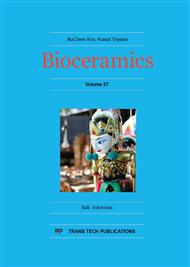[1]
P.B. Malafaya, G.A. Silva, R.L. Reis, Natural–origin polymers as carriers and scaffolds for biomolecules and cell delivery in tissue engineering applications, Adv. Drug Deliv. Rev., 59 (2007) 207–233.
DOI: 10.1016/j.addr.2007.03.012
Google Scholar
[2]
F.M. Chen, M. Zhang, Z.F. Wu, Toward delivery of multiple growth factors in tissue engineering, Biomaterials, 31 (2010) 6279-6308.
DOI: 10.1016/j.biomaterials.2010.04.053
Google Scholar
[3]
M. Yamamoto, Y. Ikada, Y. Tabata, Controlled release of growth factors based on biodegradation of gelatin hydrogel, J. Biomater. Sci. Polym. Edn., 12 (2001) 77–88.
DOI: 10.1163/156856201744461
Google Scholar
[4]
M. Ozeki, Y. Tabata, In vivo degradability of hydrogels prepared from different gelatins by various cross-linking methods, J Biomater Sci Polym Edn., 16 (2005) 549–610.
DOI: 10.1163/1568562053783731
Google Scholar
[5]
T. Puspitasari, K.M.L. Raja, D.S. Pangerteni, A. Patriati, E.G.R. Putra, Structural organization of poly(vinyl alcohol) hydrogels obtained by freezing/thawing and γ-irradiation processes: A small-angle neutron scattering (SANS) study, Procedia Chemistry, 4 (2012).
DOI: 10.1016/j.proche.2012.06.026
Google Scholar
[6]
L.E. Millon, M.P. Nieh, J.L. Hutter, W. Wan, SANS characterization of an anisotropic poly(vinyl alcohol) hydrogel with vascular applications, Macromol., 40 (2007) 3655–3662.
DOI: 10.1021/ma062781f
Google Scholar
[7]
T. Saito, Y. Tabata, Preparation of gelatin hydrogels incorporating low-molecular-weight heparin for anti-fibrotic therapy, Acta Biomaterialia, 8 (2012) 646–652.
DOI: 10.1016/j.actbio.2011.10.025
Google Scholar
[8]
S.C.G. Leeuwenburgh, I.D. Ana, J.A. Jansen, Sodium citrate as an effective dispersant for the synthesis of inorganic–organic composites with a nanodispersed mineral phase, Acta Biomaterialia, 6 (2010) 836–844.
DOI: 10.1016/j.actbio.2009.09.005
Google Scholar
[9]
I. Rehman, W. Bonfield, Characterization of hydroxyapatite and carbonated apatite by photo acoustic FTIR spectroscopy, J. Mater. Sci.: Mater. Med., 8 (1997) 1-4.
DOI: 10.1023/a:1018570213546
Google Scholar
[10]
Z. Meng, X. Zheng, K. Tang, J. Liu, Z. Ma, Q. Zhao, Dissolution and regeneration of collagen fibers using ionic liquid, International J. Biol. Macromol., 51 (2012) 440– 448.
DOI: 10.1016/j.ijbiomac.2012.05.030
Google Scholar
[11]
W. Friess, G. Lee, Basic thermoanalytical studies of insoluble collagen matrices, Biomaterials, 17 (1996) 2289-2294.
DOI: 10.1016/0142-9612(96)00047-6
Google Scholar
[12]
T. Lhermusier, H. Chap, B. Payrastre, Platelet membrane phospholipid asymmetry: from the characterization of a scramblase activity to the identification of an essential protein mutated in Scott syndrome, J. Thromb. Haemost., 9 (2011) 1883–1891.
DOI: 10.1111/j.1538-7836.2011.04478.x
Google Scholar
[13]
O.A. Hafiyyah, The effect of gelatin-carbonated hydroxyl apatite membrane composition on platelet rich plasma (prp) loading percentage, Thesis, Gadjah Mada University, (2013).
Google Scholar
[14]
A.S. Hoffman, Hydrogels for biomedical applications, Adv. Drug Deliv. Rev., 43 (2002) 3–12.
Google Scholar
[15]
M.G. Haugh, M.J. Jaasma, F.J. O'Brien, The effect of dehydrothermal treatment on the mechanical and structural properties of collagen-GAG scaffolds, J. Biomed. Mater. Res. A, 89 (2009) 363-369.
DOI: 10.1002/jbm.a.31955
Google Scholar
[16]
C.C. Lin, A.T. Metters, Hydrogels in controlled release formulations: network design and mathematical modeling, Adv. Drug Deliv. Rev., 58 (2006) 1379–1408.
DOI: 10.1016/j.addr.2006.09.004
Google Scholar
[17]
N. El Kadi, N. Taulier, J.Y. Le Huerou, M. Gindre, W. Urbach, I. Nwigwe, P.C. Kahn, M. Waks, Unfolding and refolding of bovine serum albumin at acid pH: Ultrasound and structural studies, Biophys. J., 91 (2006) 3397–3404.
DOI: 10.1529/biophysj.106.088963
Google Scholar
[18]
R. Wimmer, M. Olsson, M.T.N. Petersen, R. Hatti-Kaul, S.B. Petersen, N. Muller, Towards a molecular level understanding of protein stabilization: the interaction between lysozyme and sorbitol, J. Biotech., 55 (1997) 85–100.
DOI: 10.1016/s0168-1656(97)00061-8
Google Scholar
[19]
I.M. Al-Ruqaie, S. Kasapis, R. Abeysekera, Structural properties of pectin-gelatin gels. Part II: effect of sucrose/glucose syrup, Carbohyd. Polym., 34 (1997) 309-321.
DOI: 10.1016/s0144-8617(97)00107-0
Google Scholar
[20]
J.C. Harrington, E.R. Morris, Conformational ordering and gelation of gelatin in mixtures with soluble polysaccharides, Food Hydrocoll., 23 (2009) 327–336.
DOI: 10.1016/j.foodhyd.2008.03.003
Google Scholar


